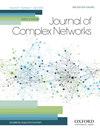A method based on link prediction for identifying set of super-spreaders in complex networks
IF 1.5
4区 数学
Q2 MATHEMATICS, INTERDISCIPLINARY APPLICATIONS
引用次数: 1
Abstract
Identifying a group of key nodes with enormous capability for spreading information to other network nodes is one of the favourable research topics in complex networks. In most existing methods, only the current status of the network is used for identifying and selecting the member of these groups. The main weakness of these methods is a lack of attention to the highly dynamic nature of complex networks and continuous changes in them in terms of creating and eliminating nodes and links. This matter makes the selected group have no proper performance in spreading information relative to other nodes. Therefore, this article presents a novel method for identifying spreader nodes and selecting a superior set from them. In the proposed method, the diffusion power of network nodes is calculated in the first step, and some are selected as influential nodes. In the following steps, it is tried to modify the list of selected nodes by predicting the network variation. Six datasets gathered from real-world networks are utilized for evaluation. The proposed method and other methods are tested to evaluate their spread of influence and time complexity. Results show that using the link prediction in the proposed method can enhance the spread of influence by the selected set compared to other methods so that the spread of influence in some datasets is more than 30一种基于链路预测的复杂网络超传播者集识别方法
在复杂网络中,识别一组具有向其他网络节点传播信息能力的关键节点是一个重要的研究课题。在大多数现有方法中,仅使用网络的当前状态来识别和选择这些组的成员。这些方法的主要缺点是缺乏对复杂网络的高度动态性以及它们在创建和消除节点和链接方面的持续变化的关注。这一问题使得所选组相对于其他节点的信息传播性能不佳。因此,本文提出了一种识别扩散节点并从中选择优集的新方法。在该方法中,首先计算网络节点的扩散能力,并选择一些有影响的节点。在接下来的步骤中,尝试通过预测网络变化来修改所选节点的列表。从现实世界的网络中收集的六个数据集被用于评估。对该方法和其他方法进行了测试,以评估其影响范围和时间复杂度。结果表明,与其他方法相比,该方法中使用链接预测可以增强所选数据集的影响力传播,某些数据集的影响力传播超过30 %。另一方面,该方法的时间复杂度证实了它在非常大的网络中的实用性。
本文章由计算机程序翻译,如有差异,请以英文原文为准。
求助全文
约1分钟内获得全文
求助全文
来源期刊

Journal of complex networks
MATHEMATICS, INTERDISCIPLINARY APPLICATIONS-
CiteScore
4.20
自引率
9.50%
发文量
40
期刊介绍:
Journal of Complex Networks publishes original articles and reviews with a significant contribution to the analysis and understanding of complex networks and its applications in diverse fields. Complex networks are loosely defined as networks with nontrivial topology and dynamics, which appear as the skeletons of complex systems in the real-world. The journal covers everything from the basic mathematical, physical and computational principles needed for studying complex networks to their applications leading to predictive models in molecular, biological, ecological, informational, engineering, social, technological and other systems. It includes, but is not limited to, the following topics: - Mathematical and numerical analysis of networks - Network theory and computer sciences - Structural analysis of networks - Dynamics on networks - Physical models on networks - Networks and epidemiology - Social, socio-economic and political networks - Ecological networks - Technological and infrastructural networks - Brain and tissue networks - Biological and molecular networks - Spatial networks - Techno-social networks i.e. online social networks, social networking sites, social media - Other applications of networks - Evolving networks - Multilayer networks - Game theory on networks - Biomedicine related networks - Animal social networks - Climate networks - Cognitive, language and informational network
 求助内容:
求助内容: 应助结果提醒方式:
应助结果提醒方式:


